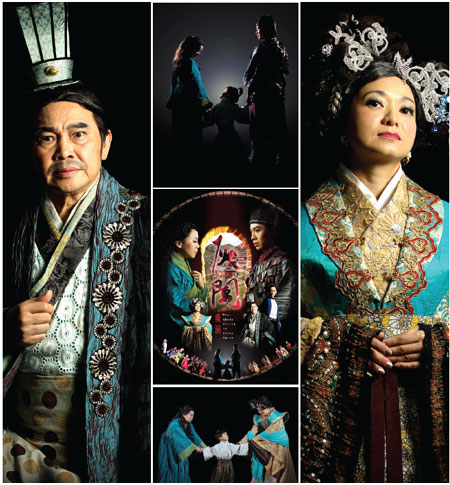The Chalk Circle in China
Updated: 2015-08-14 07:52
By Agnes Lu in Hong Kong(HK Edition)
|
|||||||||
The Chalk Circle in China, Leung Shing-him (Yatyau)'s award winning adaptation of a Bertolt Brecht play, returns to the stage tonight at Ko Shan Theatre, after a five year hiatus. This time the play is revised with nuances and cultural flourishes intended to resonate with the Hong Kong audience.
The adaptation is set amid the wars during China's Spring and Autumn Period (770-476 BC). Besieged by the enemy, the prince's consort is forced to flee the palace, leaving behind her infant son, and only child. The baby boy is discovered by a lowly servant girl, who takes him home and raises and nurtures him through times of hardship.
When the war is over years later, the consort suddenly turns up one day to reclaim her child. The tug of war between the two mothers continues until the dispute is taken before a judge, who must determine which of the two claimants is the most suitable mother.
When Yatyau, who adapted and co-directed the play, first took the play to the stage in 2010, he struggled to "orientalize" the characters and political allegories of the iconic German playwright's classic, The Caucasian Chalk Circle.
Yatyau's efforts were rewarded when the play, performed by Class 7A Drama Group in Hong Kong, was recognized as one of the Ten Most Popular Productions at the 20th Hong Kong Drama Awards in 2010.

Ironically, Brecht's work is a re-write of an ancient Chinese zaju (a form of Chinese drama) from the Yuan Dynasty (1271-1368). Yatyau tried to restore the Western play back to its origins. He said the Brecht play discusses the true ownership of land, while his adaptation puts some new thoughts on social justice.
"In his work Brecht questioned whether the ownership of land belonged to the nominal owners, or to the people who truly love the place," Yatyau said, "I hope our audience can reflect on those issues about our public resources in today's capitalistic Hong Kong."
The new production uses minimalist staging, reminiscent of the aesthetics of traditional Chinese theater. When the heroine crosses a broken wooden bridge in terror, there is no stage prop to represent the bridge. The drama is communicated only by the performance, so that the audience remain focused solely on the intense anxiety and horror portrayed by the actress.
The performers have re-interpreted the roles they play. "During the first performances I imagined my character to be a weak, pusillanimous and soft-spoken girl. Now, I understand the toughness deep in her heart," said Grace Yuen, who plays the servant girl.
The adaptation maintains the signature estrangement of Brecht's play. The narrative is interrupted frequently by a narrator who advances the plot, with incidental music intended to break the stage illusion and to steer the audience from sentimental responses, which are likely to becloud critical thinking.
As the drama unfolds, the judge draws a chalk circle, placing the child in the center. He instructs the two women whoever pulls the boy out of the circle can claim him as her son, making it clear that an intensive physical confrontation might break the boy's arms.
Yatyau considers the scene a thought provoking metaphor on present day Hong Kong, in the quarrelsome battle for social justice. It is for the judge to decide whether the callous hierarchy representing wealth and power must prevail or whether the poor servant girl, should be acknowledged as the "true mother".
agnes@chinadailyhk.com
|
The Chalk Circle in China on show in Cantonese until Sunday at Ko Shan Theatre. Provided to China Daily |
(HK Edition 08/14/2015 page10)
